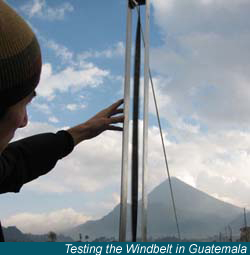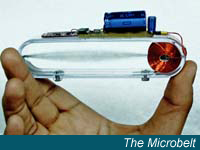Windbelt - Reinventing wind power

If you look up aeroelastic flutter on Youtube, the first thing you’ll find is footage of the spectacular Tacoma Narrows bridge collapse back in 1940. Shawn Frayne has however given the infamous phenomenon a chance to redeem itself as a new form of cheap, clean wind energy.
‘Typically aeroelastic flutter is a destructive effect. But what the Windbelt does is try to capture it for the purposes of electricity production,’ explains Frayne, the brains behind the Windbelt and the founder of Humdinger Wind Energy.
The Windbelt’s key component is a taut membrane of mylar-coated taffeta, which vibrates as wind flows over it – this movement, triggered by airflow, is what is known as aeroelastic flutter (see the windbelt in action in the video below).
The Windbelt’s key component is a taut membrane of mylar-coated taffeta, which vibrates as wind flows over it – this movement, triggered by airflow, is what is known as aeroelastic flutter (see the windbelt in action in the video below).
‘That oscillation moves a set of permanent magnets that are on the membrane itself at one of the ends,’ Frayne continues. The motion of these magnets between two copper coil induces an electrical current.
Frayne’s inspiration for the Windbelt was a trip to Haiti in 2004. ‘I realised that it’d be nice to have a small source of power that could be locally produced. Solar cells would be very difficut to produce locally, so I turned to wind,’ explains Frayne. The prohibitive cost of wind turbines however forced him to think outside the box, and the result was the Windbelt.

Developing the Windbelt's design has been a long process, with field trials held from Guatemala to Hong Kong. Frayne and his team have now refined the Windbelt to maximise its power output at different sizes, from the pocket-sized Microbelt to the larger Windcell.
‘A lot of people think that the Windbelt would only work at one speed, or that you’d have to retension it for different windspeeds, but that’s not the case,’ says Frayne. ‘Our challenge is in designing the system so we have the lowest flutter threshold possible and that we can maintain flutter without re-tensioning in a decent band of wind speeds. We typically are trying to tap 3 m/s up to 12 m/s’ (3 m/s is defined as a gentle breeze - enough to make twigs on a tree branch sway).
Frayne’s inspiration for the Windbelt was a trip to Haiti in 2004. ‘I realised that it’d be nice to have a small source of power that could be locally produced. Solar cells would be very difficut to produce locally, so I turned to wind,’ explains Frayne. The prohibitive cost of wind turbines however forced him to think outside the box, and the result was the Windbelt.

Developing the Windbelt's design has been a long process, with field trials held from Guatemala to Hong Kong. Frayne and his team have now refined the Windbelt to maximise its power output at different sizes, from the pocket-sized Microbelt to the larger Windcell.
‘A lot of people think that the Windbelt would only work at one speed, or that you’d have to retension it for different windspeeds, but that’s not the case,’ says Frayne. ‘Our challenge is in designing the system so we have the lowest flutter threshold possible and that we can maintain flutter without re-tensioning in a decent band of wind speeds. We typically are trying to tap 3 m/s up to 12 m/s’ (3 m/s is defined as a gentle breeze - enough to make twigs on a tree branch sway).
Wind energy for the developing world
The Windcell, measuring a metre in length, is particularly suited to providing electricity in isolated areas of the developing world where solar or conventional wind power are too costly or simply inaccessible. Producing around 0.2 kWh (enough to power 10 energy saving lightbulbs), its energy output is not enormous, but it's enough to make a real difference in some areas, replacing kerosene lighting in Haiti for example.
‘It makes sense for situations when you don’t need a whole lot of power and you’ve got some wind. You could have just a few Windcells that harvest enough energy from the wind to power up lighting or charge some batteries,’ says Frayne. ‘There’s a couple of governments that we’re talking to about rolling out the Windcell to dispersed communities.’
The recent earthquake means that there is a greater need than ever before for small scale power systems in Haiti. ‘The Windbelt was not going to have a big impact in Port au Prince, given the limited wind resource in the capital -- so the potential impact is still likely to be greatest outside of the capital, once the systems are refined enough to be deployed.’
The recent earthquake means that there is a greater need than ever before for small scale power systems in Haiti. ‘The Windbelt was not going to have a big impact in Port au Prince, given the limited wind resource in the capital -- so the potential impact is still likely to be greatest outside of the capital, once the systems are refined enough to be deployed.’
Frayne still hopes to push costs down even further: ‘One of our main goals is to drive the systems to a low enough cost so that the electricity produced competes with the price of electricity from coal.’
And although in most urban areas there is not enough wind, there are still opportunities for the Windcell if you know where to look - on the sides of skyscrapers or under bridges for example. ‘We can go where turbines can’t go – there’s half a million bridges in the US and a lot of times you have good airflow under a bridge’, he elaborates.
And although in most urban areas there is not enough wind, there are still opportunities for the Windcell if you know where to look - on the sides of skyscrapers or under bridges for example. ‘We can go where turbines can’t go – there’s half a million bridges in the US and a lot of times you have good airflow under a bridge’, he elaborates.
 Small is beautiful
Small is beautiful
The Windcell's high-flying little brother is the Microbelt, which fits into the palm of your hand and is 10 times more efficient than existing miniature wind turbines and other systems. ‘We’re aiming to get our system down to the size of a postage stamp eventually,’ says Frayne.
The Microbelt could replace batteries to power wireless sensors, for example humidity sensors in buildings or geological activity monitors. With several million of these sensors in operation worldwide, the potential is huge.
Frayne still hopes to improve the cost effectiveness of larger Windbelt systems, but one of his company’s main priorities now is to get the Windbelt out into the real world. ‘You can get a tiny box with all the components to make a wind system for a very very low price compared to anything else available,’ he says. ‘We’re trying to make the technology more accessible so it can become more ubiquitous - out there in people’s minds first of all, and then in reality.’
Frayne still hopes to improve the cost effectiveness of larger Windbelt systems, but one of his company’s main priorities now is to get the Windbelt out into the real world. ‘You can get a tiny box with all the components to make a wind system for a very very low price compared to anything else available,’ he says. ‘We’re trying to make the technology more accessible so it can become more ubiquitous - out there in people’s minds first of all, and then in reality.’
Source: physics.org
No comments:
Post a Comment